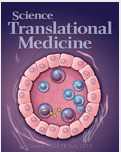Sci.Transl.Med:纳米纤维结合VEGF疗法有效治疗心脏病
2012-08-14 T.Shen 生物谷
在全球范围内,因心血管疾病,每年可导致超过1700万人死亡。一般情况下,心脏病发作的人群可以很快恢复过来,但是那些恢复过来的人更易于引发心力衰竭和后期心脏病的发作,因为其心脏组织已经被破坏了。近日,来自美国和台湾研究者的一项最新的研究成果开发了一种使用血管内皮生长因子(VEGF)的新型疗法,这种疗法可以促进血管再生。以前基于VEGF的方法都因为生长因子可以被血流很快冲走导致疗法失效,这项新的研究解
在全球范围内,因心血管疾病,每年可导致超过1700万人死亡。一般情况下,心脏病发作的人群可以很快恢复过来,但是那些恢复过来的人更易于引发心力衰竭和后期心脏病的发作,因为其心脏组织已经被破坏了。近日,来自美国和台湾研究者的一项最新的研究成果开发了一种使用血管内皮生长因子(VEGF)的新型疗法,这种疗法可以促进血管再生。以前基于VEGF的方法都因为生长因子可以被血流很快冲走导致疗法失效,这项新的研究解决了此问题。
研究小子使用了含有自装配肽类纳米纤维(nanofibers)的凝胶和VRGF结合起来,发现了纳米颗粒中类似支架的结构可以固定VEGF,使其可以在数周内缓慢进行释放。研究者诱导小鼠心脏病发作,然偶注射这种携带不同剂量的VEGF的纳米纤维进入小鼠心脏进行作用。
他们发现,这种结合疗法可以改善心脏健康,并且提供促进心血管生长、组织修复以及新组织生长的环境。研究者Hsieh表示,这种纳米纤维可以提供一种有效的环境来吸引干细胞,从而修复损伤的组织,并且更新血管。
实验进行了28天,结果显示,相比对照组(只使用VEGF或者纳米颗粒),实验组的组织再生和修复能力明显提高了。相关研究成果刊登在了国际著名杂志Science Translational Medicine上。研究者最终表示,这种新型结合疗法可以帮助心脏病患者来进行快速治疗,并且改善其生活质量。
编译自:Nanofibers may help treat heart attacks

doi:10.1126/scitranslmed.3003841
PMC:
PMID:
Instructive Nanofiber Scaffolds with VEGF Create a Microenvironment for Arteriogenesis and Cardiac Repair
Yi-Dong Lin1,2,*, Chwan-Yau Luo3,*, Yu-Ning Hu3, Ming-Long Yeh2, Ying-Chang Hsueh4,5, Min-Yao Chang2,4, Da-Ching Tsai4, Jieh-Neng Wang6, Ming-Jer Tang5,7, Erika I. H. Wei1, Matthew L. Springer8 and Patrick C. H. Hsieh1,2,3,4,5,†
Angiogenic therapy is a promising approach for tissue repair and regeneration. However, recent clinical trials with protein delivery or gene therapy to promote angiogenesis have failed to provide therapeutic effects. A key factor for achieving effective revascularization is the durability of the microvasculature and the formation of new arterial vessels. Accordingly, we carried out experiments to test whether intramyocardial injection of self-assembling peptide nanofibers (NFs) combined with vascular endothelial growth factor (VEGF) could create an intramyocardial microenvironment with prolonged VEGF release to improve post-infarct neovascularization in rats. Our data showed that when injected with NF, VEGF delivery was sustained within the myocardium for up to 14 days, and the side effects of systemic edema and proteinuria were significantly reduced to the same level as that of control. NF/VEGF injection significantly improved angiogenesis, arteriogenesis, and cardiac performance 28 days after myocardial infarction. NF/VEGF injection not only allowed controlled local delivery but also transformed the injected site into a favorable microenvironment that recruited endogenous myofibroblasts and helped achieve effective revascularization. The engineered vascular niche further attracted a new population of cardiomyocyte-like cells to home to the injected sites, suggesting cardiomyocyte regeneration. Follow-up studies in pigs also revealed healing benefits consistent with observations in rats. In summary, this study demonstrates a new strategy for cardiovascular repair with potential for future clinical translation.
本网站所有内容来源注明为“梅斯医学”或“MedSci原创”的文字、图片和音视频资料,版权均属于梅斯医学所有。非经授权,任何媒体、网站或个人不得转载,授权转载时须注明来源为“梅斯医学”。其它来源的文章系转载文章,或“梅斯号”自媒体发布的文章,仅系出于传递更多信息之目的,本站仅负责审核内容合规,其内容不代表本站立场,本站不负责内容的准确性和版权。如果存在侵权、或不希望被转载的媒体或个人可与我们联系,我们将立即进行删除处理。
在此留言








#Transl.#
68
#纳米纤维#
56
#TRA#
68
#Transl#
68
#VEGF#
70
#Med#
68
#有效治疗#
69